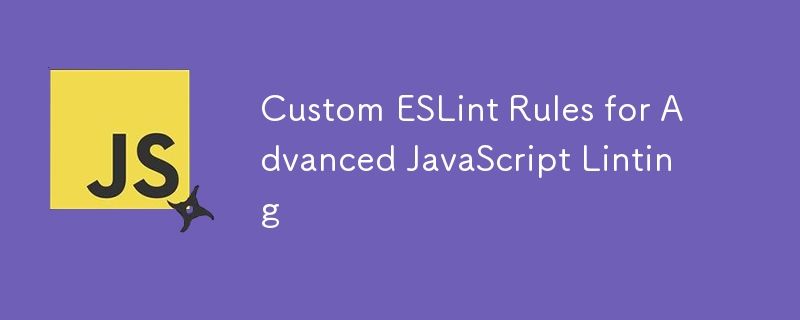Custom ESLint rules are required because standard rules cannot override all project-specific conventions, such as prohibiting specific functions outside the component, forcing API request comments, variable naming constraints, etc. 1. Create an ESLint plug-in structure, including the entry index.js and the rule file directory; 2. Write rule logic, listen to nodes through AST and implement checking logic, such as detecting function calls; 3. Register plug-in in ESLint configuration and enable rules. Common applications include controlling the location of function calls, forcing comments, and restricting import paths. It is recommended to use AST Explorer to assist in development and pay attention to performance and debugging methods.

It is not enough to write JavaScript code well. Especially in team collaboration, a unified code style and specification can reduce a lot of communication costs. ESLint is one of the most popular JavaScript code inspection tools at present, the basic rules are already very powerful, but sometimes we need more fine-grained control - at this time we need to customize ESLint rules.

Why do you need to customize ESLint rules?
Although the standard ESLint rules cover many common problems, in some specific projects or teams, there will always be some "conventional" writing styles that are not covered. for example:
- Not allowed to use a specific function outside the component
- Requires all API requests to be accompanied by a custom comment
- Some variable names require additional constraints
In these scenarios, common rules are not enough. Through custom rules, we can automatically embed project best practices into the development process, making code review more efficient and consistent.

How to create a custom ESLint rule?
The core steps of creating custom rules are not complicated, mainly including the following parts:
- Create an ESLint plugin structure
- Writing rules logic
- Register and enable rules
1. Create the ESLint plugin structure
You can initialize a plug-in package through npm, or create a local rule directory directly in the project. The basic structure is as follows:

eslint-plugin-my-rules/ ├── index.js ├── rules/ │ └── no-direct-api-call.js
index.js is a plug-in entry file that is responsible for exporting all rules. Each rule is a separate JS file that defines the behavior of the rule.
2. Write rule logic
The rules of ESLint are essentially a function that receives context objects and then listens for nodes in the AST (abstract syntax tree). For example, if you want to prohibit calling fetchData() function, you can write it like this:
module.exports = {
create(context) {
return {
CallExpression(node) {
if (node.callee.name === 'fetchData') {
context.report({ node, message: 'Direct use of fetchData is not allowed.' });
}
},
};
},
}; The meaning of this code is: When a function named fetchData is detected, an error prompt is not allowed to be used directly.
3. Register and enable rules
Add plugins and rules to your ESLint configuration file:
{
"plugins": ["my-rules"],
"rules": {
"my-rules/no-direct-api-call": "error"
}
} Make sure you have installed this plugin (if it is locally developed, it can be introduced via npm link or file: :).
Common application scenarios and suggestions
Control function call location
For example, if you do not want a tool function to be used outside of React components, you can judge whether the call location is legal based on the current context.
Forced document comments
For public APIs or core functions, it is required that there be a JSDoc annotation. Implementation by parsing comment nodes in AST.
Disable imports of certain modes
For example, if you don't want developers to import modules directly from a deep path, you can use regular matching of the import path:
if (/\/utils\/.*\.js$/.test(source.value)) {
context.report({ node, message: 'Do not import from utils directly.' });
}Tips and precautions
- Debugging rules : You can use ESLint extension to view the effects in real time in VS Code, or you can write unit test verification rule behavior.
- AST Structure Understanding : It is recommended to use AST Explorer to observe the AST structure corresponding to different codes, which is very helpful for writing precise rules.
- Performance considerations : The rules should be as light as possible to avoid doing a lot of calculations when traversing the entire AST.
Basically that's it. Customized ESLint rules sound a bit advanced, but in fact, as long as you master the basic structure of AST and the plug-in mechanism of ESLint, you can get started quickly. The key is to clarify what you want to check and find the right way to describe it.
The above is the detailed content of Custom ESLint Rules for Advanced JavaScript Linting. For more information, please follow other related articles on the PHP Chinese website!

Hot AI Tools

Undress AI Tool
Undress images for free

Undresser.AI Undress
AI-powered app for creating realistic nude photos

AI Clothes Remover
Online AI tool for removing clothes from photos.

Clothoff.io
AI clothes remover

Video Face Swap
Swap faces in any video effortlessly with our completely free AI face swap tool!

Hot Article

Hot Tools

Notepad++7.3.1
Easy-to-use and free code editor

SublimeText3 Chinese version
Chinese version, very easy to use

Zend Studio 13.0.1
Powerful PHP integrated development environment

Dreamweaver CS6
Visual web development tools

SublimeText3 Mac version
God-level code editing software (SublimeText3)
 How to make an HTTP request in Node.js?
Jul 13, 2025 am 02:18 AM
How to make an HTTP request in Node.js?
Jul 13, 2025 am 02:18 AM
There are three common ways to initiate HTTP requests in Node.js: use built-in modules, axios, and node-fetch. 1. Use the built-in http/https module without dependencies, which is suitable for basic scenarios, but requires manual processing of data stitching and error monitoring, such as using https.get() to obtain data or send POST requests through .write(); 2.axios is a third-party library based on Promise. It has concise syntax and powerful functions, supports async/await, automatic JSON conversion, interceptor, etc. It is recommended to simplify asynchronous request operations; 3.node-fetch provides a style similar to browser fetch, based on Promise and simple syntax
 JavaScript Data Types: Primitive vs Reference
Jul 13, 2025 am 02:43 AM
JavaScript Data Types: Primitive vs Reference
Jul 13, 2025 am 02:43 AM
JavaScript data types are divided into primitive types and reference types. Primitive types include string, number, boolean, null, undefined, and symbol. The values are immutable and copies are copied when assigning values, so they do not affect each other; reference types such as objects, arrays and functions store memory addresses, and variables pointing to the same object will affect each other. Typeof and instanceof can be used to determine types, but pay attention to the historical issues of typeofnull. Understanding these two types of differences can help write more stable and reliable code.
 JavaScript time object, someone builds an eactexe, faster website on Google Chrome, etc.
Jul 08, 2025 pm 02:27 PM
JavaScript time object, someone builds an eactexe, faster website on Google Chrome, etc.
Jul 08, 2025 pm 02:27 PM
Hello, JavaScript developers! Welcome to this week's JavaScript news! This week we will focus on: Oracle's trademark dispute with Deno, new JavaScript time objects are supported by browsers, Google Chrome updates, and some powerful developer tools. Let's get started! Oracle's trademark dispute with Deno Oracle's attempt to register a "JavaScript" trademark has caused controversy. Ryan Dahl, the creator of Node.js and Deno, has filed a petition to cancel the trademark, and he believes that JavaScript is an open standard and should not be used by Oracle
 What is the cache API and how is it used with Service Workers?
Jul 08, 2025 am 02:43 AM
What is the cache API and how is it used with Service Workers?
Jul 08, 2025 am 02:43 AM
CacheAPI is a tool provided by the browser to cache network requests, which is often used in conjunction with ServiceWorker to improve website performance and offline experience. 1. It allows developers to manually store resources such as scripts, style sheets, pictures, etc.; 2. It can match cache responses according to requests; 3. It supports deleting specific caches or clearing the entire cache; 4. It can implement cache priority or network priority strategies through ServiceWorker listening to fetch events; 5. It is often used for offline support, speed up repeated access speed, preloading key resources and background update content; 6. When using it, you need to pay attention to cache version control, storage restrictions and the difference from HTTP caching mechanism.
 Handling Promises: Chaining, Error Handling, and Promise Combinators in JavaScript
Jul 08, 2025 am 02:40 AM
Handling Promises: Chaining, Error Handling, and Promise Combinators in JavaScript
Jul 08, 2025 am 02:40 AM
Promise is the core mechanism for handling asynchronous operations in JavaScript. Understanding chain calls, error handling and combiners is the key to mastering their applications. 1. The chain call returns a new Promise through .then() to realize asynchronous process concatenation. Each .then() receives the previous result and can return a value or a Promise; 2. Error handling should use .catch() to catch exceptions to avoid silent failures, and can return the default value in catch to continue the process; 3. Combinators such as Promise.all() (successfully successful only after all success), Promise.race() (the first completion is returned) and Promise.allSettled() (waiting for all completions)
 Leveraging Array.prototype Methods for Data Manipulation in JavaScript
Jul 06, 2025 am 02:36 AM
Leveraging Array.prototype Methods for Data Manipulation in JavaScript
Jul 06, 2025 am 02:36 AM
JavaScript array built-in methods such as .map(), .filter() and .reduce() can simplify data processing; 1) .map() is used to convert elements one to one to generate new arrays; 2) .filter() is used to filter elements by condition; 3) .reduce() is used to aggregate data as a single value; misuse should be avoided when used, resulting in side effects or performance problems.
 JS roundup: a deep dive into the JavaScript event loop
Jul 08, 2025 am 02:24 AM
JS roundup: a deep dive into the JavaScript event loop
Jul 08, 2025 am 02:24 AM
JavaScript's event loop manages asynchronous operations by coordinating call stacks, WebAPIs, and task queues. 1. The call stack executes synchronous code, and when encountering asynchronous tasks, it is handed over to WebAPI for processing; 2. After the WebAPI completes the task in the background, it puts the callback into the corresponding queue (macro task or micro task); 3. The event loop checks whether the call stack is empty. If it is empty, the callback is taken out from the queue and pushed into the call stack for execution; 4. Micro tasks (such as Promise.then) take precedence over macro tasks (such as setTimeout); 5. Understanding the event loop helps to avoid blocking the main thread and optimize the code execution order.
 Understanding Event Bubbling and Capturing in JavaScript DOM events
Jul 08, 2025 am 02:36 AM
Understanding Event Bubbling and Capturing in JavaScript DOM events
Jul 08, 2025 am 02:36 AM
Event bubbles propagate from the target element outward to the ancestor node, while event capture propagates from the outer layer inward to the target element. 1. Event bubbles: After clicking the child element, the event triggers the listener of the parent element upwards in turn. For example, after clicking the button, it outputs Childclicked first, and then Parentclicked. 2. Event capture: Set the third parameter to true, so that the listener is executed in the capture stage, such as triggering the capture listener of the parent element before clicking the button. 3. Practical uses include unified management of child element events, interception preprocessing and performance optimization. 4. The DOM event stream is divided into three stages: capture, target and bubble, and the default listener is executed in the bubble stage.






